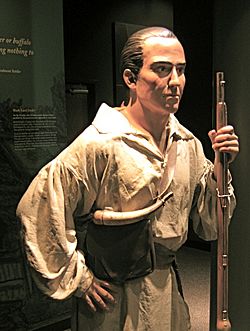Richard Pearis facts for kids
Quick facts for kids
Richard Pearis
|
|
|---|---|

A life-size model of Richard Pearis at the Upcountry History Museum in Greenville, South Carolina
|
|
| Born | 1725 |
| Died | 1794 (aged 69) |
| Resting place | Bahamas |
| Occupation | trader, Indian agent, planter, soldier |
| Spouse(s) | Cherokee woman |
| Military career | |
| Allegiance | |
| Service/ |
|
| Years of service | 1756-1763, 1775-1776 |
| Rank | Captain |
| Battles/wars | French and Indian War American Revolutionary War |
Richard Pearis (1725–1794) was an early explorer and trader in what is now Upstate South Carolina. He also served as an officer for the British side, known as a Loyalist, during the American Revolution.
Contents
Richard Pearis's Early Life
Richard Pearis was born in Ireland in 1725. His parents, George and Sarah Pearis, were a wealthy family. When Richard was ten, his family moved to the Shenandoah Valley in Virginia. By 1750, Richard owned a large amount of land, about 1,200 acres, near Winchester. He lived there with his wife, Rhoda, and their three children.
What Did Richard Pearis Do for a Living?
By 1753, Pearis started trading goods with the Cherokee Nation. He partnered with Nathaniel Gist to open a trading post near what is now Kingsport, Tennessee. In the mid-1750s, Pearis also began trading with the Cherokee people in South Carolina. He had a son named George with a Cherokee woman.
Pearis was known for being a powerful speaker. He gained favor with Virginia's governor, Robert Dinwiddie. During the French and Indian War, Pearis led a group of Cherokee warriors. They went on the Sandy Creek Expedition in 1756. He also served under British General John Forbes. They captured Fort Duquesne in 1758. After the war, Pearis became an agent for the British government, working with Native American tribes in colonial Maryland.
Richard Pearis and Land Deals
In 1770, Pearis and another frontier leader, Jacob Hite, created fake letters. These letters claimed that Cherokee leaders, like Oconostota, wanted to give land to the Virginia colony. Pearis also said he had a deed from the Cherokee for a large area of land. This land was about twelve square miles in what is now Greenville County, South Carolina.
An interpreter named John Watts warned the British Indian superintendent, John Stuart. Watts said Pearis was "a very dangerous fellow" who would cause trouble. He believed Pearis would tell the Native Americans "any lies to please them."
With help from a Native American ally named Saluy, Pearis got approval for his land grant. This likely happened because he agreed to cancel the Cherokee leaders' trading debts. However, in 1772, Stuart complained to the governor of South Carolina. He said Pearis had gotten the land by giving alcohol to the Native Americans. The governor then told Stuart to take Pearis to court. This was because Pearis might have broken a 1739 law. This law said British citizens could not own Native American land. Meanwhile, Pearis had already started selling parts of the land to other white settlers.
In November 1773, a court in Ninety Six found Pearis guilty of owning Native American land. He had to give up his deed. But the next month, he got another deed from Cherokee leaders. This new deed gave his son George more than twelve square miles of land. George then quickly transferred most of this land to his father.
Richard Pearis's Plantation and the American Revolution
Sometime after 1770, Pearis, his family, and their twelve enslaved people started clearing land. They cleared about 100 acres near the Reedy River falls. This area is now the center of modern Greenville, South Carolina. They planted grain and fruit trees on a large farm Pearis called "Great Plains." Pearis built a strong house and a store. He also built a grist mill (for grinding grain) and a sawmill.
In 1775, Pearis wanted to be a commissioner for the American patriots, working with Native Americans. When someone else got the job, Pearis joined the British side. He became a captain for the Loyalists, also called Tories. On December 12, 1775, Patriot Colonel Richard Richardson captured Pearis and eight other Loyalist leaders. Pearis was held in chains in Charleston for nine months. After that, he went to British West Florida. In July 1776, Pearis's house and farm buildings were burned by his opponents in the backcountry.
Pearis continued to serve with Loyalist forces during the American Revolution. This time was like a civil war in the frontier areas. After the city of Augusta, Georgia fell to the patriots in June 1781, Pearis was captured again. General Andrew Pickens saved Pearis's life. He put Pearis in a boat and sent him down the river. This kept him away from angry soldiers who might have killed him.
The state of South Carolina took away Pearis's land. Pearis spent the rest of his life as a planter in the Bahamas. The British government paid him a lot of money for the South Carolina lands. Many people argued that he never legally owned these lands in the first place.
Today, north of Greenville, there is a mountain called Paris Mountain. It and Paris Mountain State Park are named after Richard Pearis.
Images for kids
-
A mid-twentieth century drawing of Pearis's Greenville plantation, "Great Plains," from a historical marker near the Reedy River.


